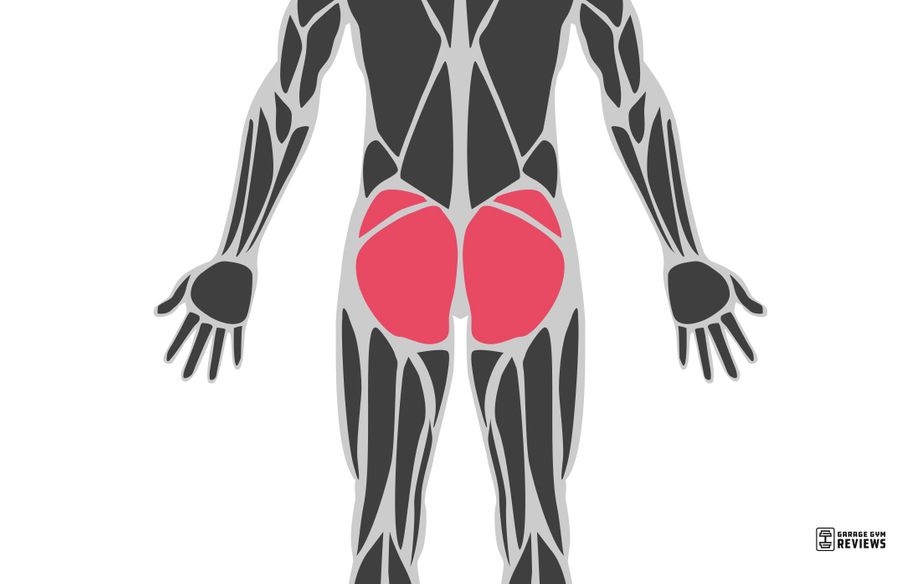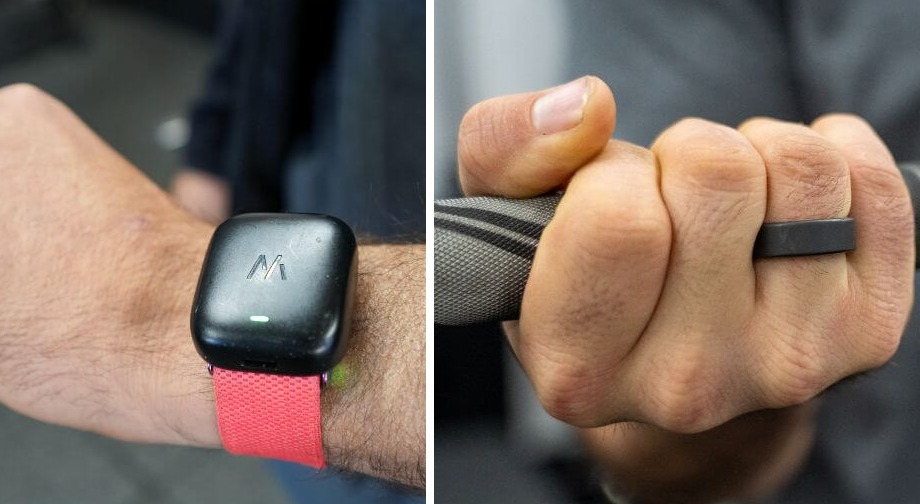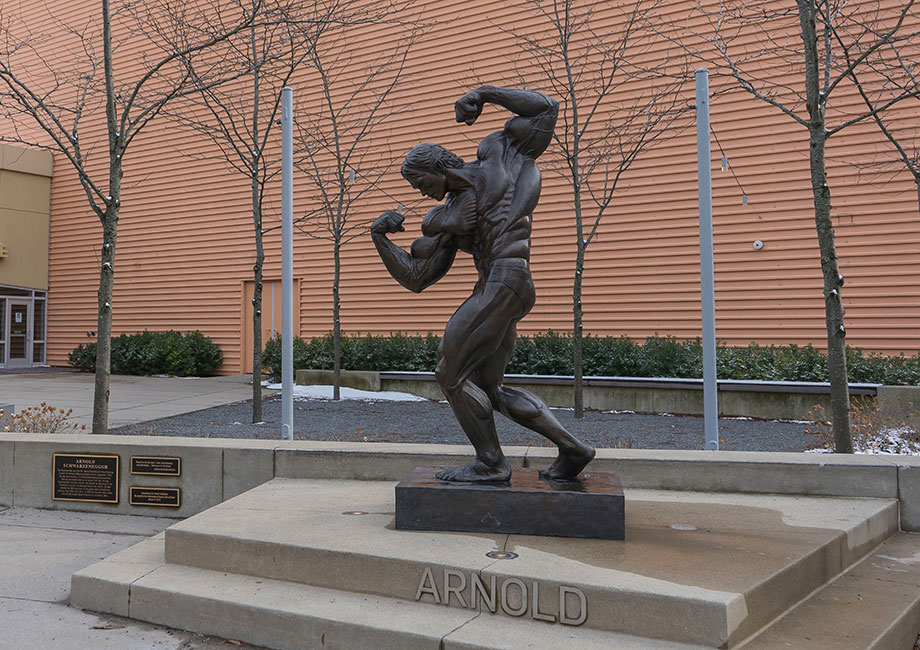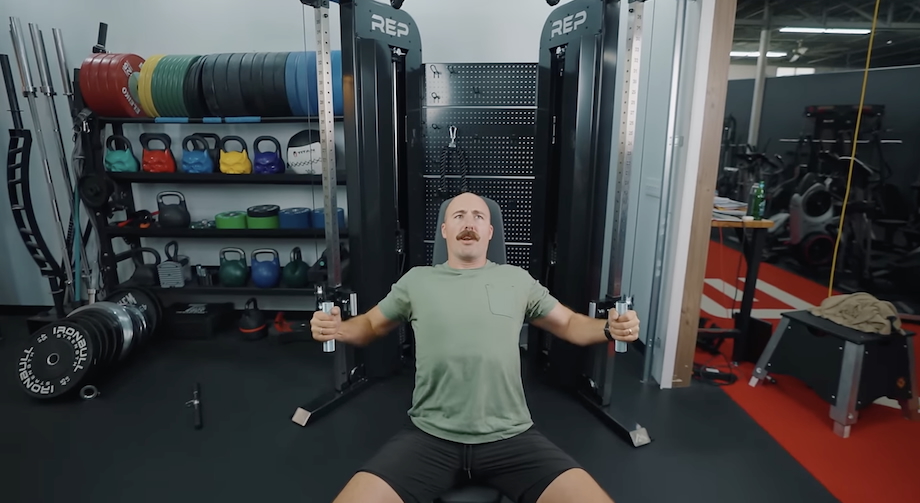Glute training has become increasingly popular over the last several years (and for good reason). Butt exercises like hip thrusts, glute kickbacks, and fire hydrants pop up on my social media feed all the time. I’m absolutely thrilled this underrated muscle group is finally having its moment to shine in the spotlight.
As a certified personal trainer (CPT), I notice that the glutes and hamstrings are commonly underused and underdeveloped. However, it has been demonstrated that when we lack strength in our glutes, it is correlated with both knee pain1 and chronic low back pain2.
In this guide, I’m going to cover some easy resistance band exercises for glutes that you can do at home or in the gym. Most of the butt exercises I will cover are scalable and can be done with just bodyweight, resistance bands, or modified for even more resistance with weights.
Why Train Your Glutes?
Your glutes are quite large and one of the major muscle groups that make up your legs (in addition to your quads and hamstrings, of course). The main function of the glute is to extend and externally rotate3 the thigh. For athletes, strong glutes are important for sprinting and kicking.
However, glutes are also important for everyday occurrences like rising from a seated position, walking upstairs or up a hill, and running. The glutes also provide support to your trunk and stabilize your pelvis3.
Adding glute-specific exercises to your routine could play a big part in your overall athletic performance. I should know—in my early twenties I had underdeveloped glutes and hamstrings. Once I started incorporating glute-focused training into my workouts my back squat improved, my deadlifts became pain-free, and the low back pain I felt on a daily basis reduced dramatically.
One 2020 study4 published by the International Journal of Exercise Science found that the barbell back squat and barbell hip thrust—a super glute-specific exercise—both show nearly equal improvement for overall lower body strength and performance.
The research was conducted on a group of female teenage soccer players who performed an almost identical full-body workout routine two times per week for six weeks. The exception was that while one group had back squats incorporated into the routine, the other group replaced the squat with the barbell hip thrust. The rest of the workout remained the same.
The study showed no major differences in improvement with the two groups—both groups of athletes improved their kicking distance, vertical jump, and broad jump. Needless to say, although squats are often the top choice for building leg strength, the hip thrust could provide an adequate variation.
Build Glute Strength And Size With Resistance Bands
For the purposes of this glute-specific guide, I’m going to focus on band resistance isolation glute exercises that will help you target the sensation of how to squeeze and engage your glutes. You will get an additional benefit of growing muscle and strength with regular exercise and repetition.
Muscle hypertrophy (aka muscle growth) happens when your muscles undergo resistance training. In a 2012 study5 published by the Journal of Physiology, researchers found that not only does the amount of weight lifted lead to muscle gains, but the amount of time a muscle is under tension does as well.
If you’ve ever done more than 20 repetitions of any given exercise (even with minimal resistance), you know how real the pump feels. The study found that the more time a muscle went through a range of motion, it showed an increased muscle protein synthesis, which is the process of producing new muscle protein strands. It’s this formation of new strands that leads to muscle growth.
RELATED: Best protein shakes
That said, it’s a good idea to slow down your banded glute exercises for not only the feeling of an effective glute workout, but actual muscle growth. I’m not even suggesting ultra-slow speeds here: This study was based on quad extensions that lasted about six seconds up and six seconds down versus one second up and down.
What Type Of Bands Are We Talking?
With so many different options for resistance band training, I can see how it can get confusing to choose the right for glute-specific training.
There is more than one option for resistance bands, so I want to clarify and let you know that mini loop bands will be the best type of band for glute-specific training. Here are some of our top picks from the GGR team:
In a pinch, I’ve doubled (even tripled) a red Rogue Monster band for glute exercises. Although mini bands are ideal, with some creativity, longer loop bands will do!
Resistance Band Exercises For Glutes
Now that we’ve covered the reasons why you should care about glute training, here are some of my favorite resistance band glute movements and a few variations, too.
Banded Glute Bridge
Glute bridges are simple and effective with or without a loop resistance band. As a CPT, I often have my clients use glute bridges as a warm-up to squats, deadlifts, or lunges. I like that they are low-impact and don’t require much equipment to maximize glute recruitment.
To perform glute bridges, follow these steps:
- Lie with your back on the floor, knees bent, and feet flat on the ground.
- Place feet shoulder-width apart and have your shins vertical with your ankles and knees in alignment. If you choose to use a mini band, position it around your quads just at the top of the knee.
- Before you start the bridge, slightly tip your pelvis toward your chin—this is to help keep your core solid and braced.
- From there push through your feet to lift your butt off the floor. Keep your core braced to avoid overextension at the top.
- Slowly come back to the floor and repeat.
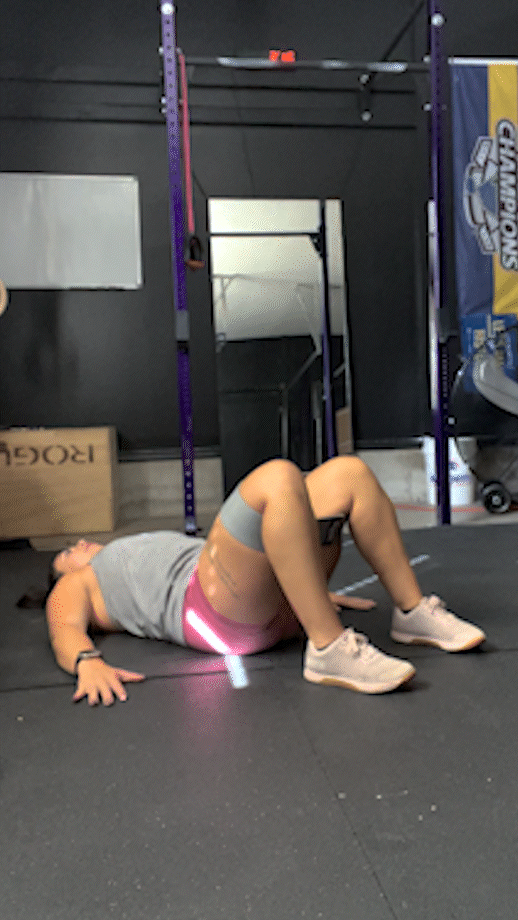
Glute bridge variations include:
- Single-leg: This is the same idea as the traditional bridge but with one leg. I like to keep the non-working leg in a 90-degree position so I’m not tempted to kick to get extra momentum.
- Frog pump: Instead of having feet on the ground, rotate your knees outward and bring the soles of your feet to touch. From this position, flex your glutes to bring your butt off the floor.
Banded Hip Thrust
Although very similar, a hip thrust is different from a glute bridge. For a hip thrust, you won’t be in the prone position with your back on the floor. Instead, you will support your upper back on either a weight bench or your couch. To perform the hip thrust, follow these steps:
- Position your mini resistance band so it’s right above your knees.
- Get in a seated position, with your back up against your chosen support, place your feet hip-width apart (and a few inches away from your glutes).
- In your starting position, you will need to brace your core and envision that you’re cinching your rib cage together.
- With a braced core, generate force into your heels and squeeze your glutes to drive your pelvis upward so your quads, core, and upper body become parallel with the floor.
- Slowly come back to the floor and repeat.
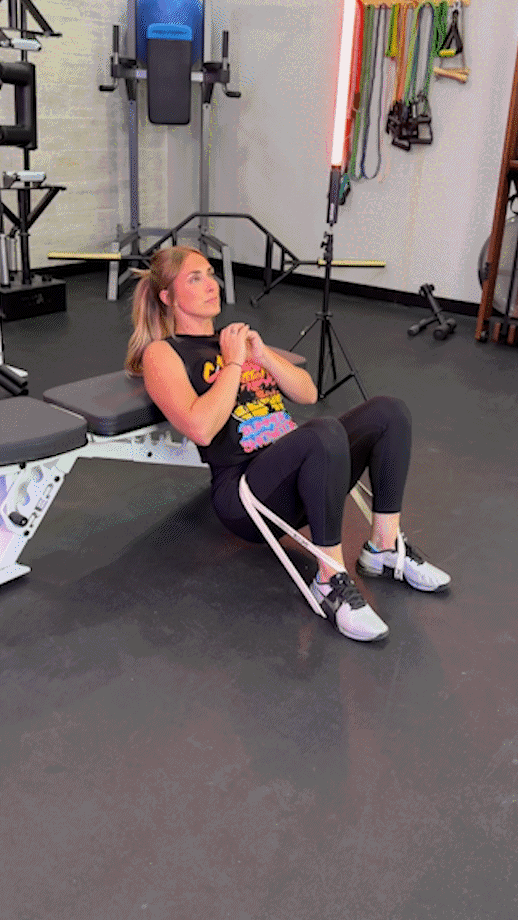
At the top of the motion, it’s easy to unbrace the core and extend through the spine, which would look like you’re arching your back. Try to keep your rib cage cinched, and your chin tucked to prevent any arching. Additionally, you can adjust your foot position if needed. Ideally your shins are vertical with ankles and knees aligned.
Hip thrust variations include:
- Single-leg hip thrust: Use the same method to set up the traditional hip thrust, but bring your feet together. To start, lift the right foot and keep your right leg bent at a 90-degree angle. With your left foot still on the ground, press into the floor and with the strength of your leg and glutes, bring your pelvis up so it’s parallel to the floor.
- Foot-elevated hip thrust: Your upper back will still be supported, but you can raise the elevation of your feet to increase your range of motion. This also doesn’t really allow for rest because your butt won’t reach the floor, which means you’ll have to just keep repping them out.
Banded Abduction
An abduction movement simply means to bring a limb away from the midline6 of the body. That said, a hip abduction just means that you’re externally rotating your thigh away from the center of your body. The most common abduction I include in my programs is the side-lying clam shell.
Here’s how to set up for a clam shell:
- Position mini band around the quads, just over the knee.
- Lie down on your side with your left and right knees stacked and your pelvis perpendicular to the floor.
- Lift your top knee away from your bottom knee without flexing too much through the entire leg. Your goal is to use the small muscles on the outside of your hips (gluteus medius)
- Stop your range of motion before your back or core muscles start to move to overcompensate for the glutes
- Lower the top knee slowly and repeat.
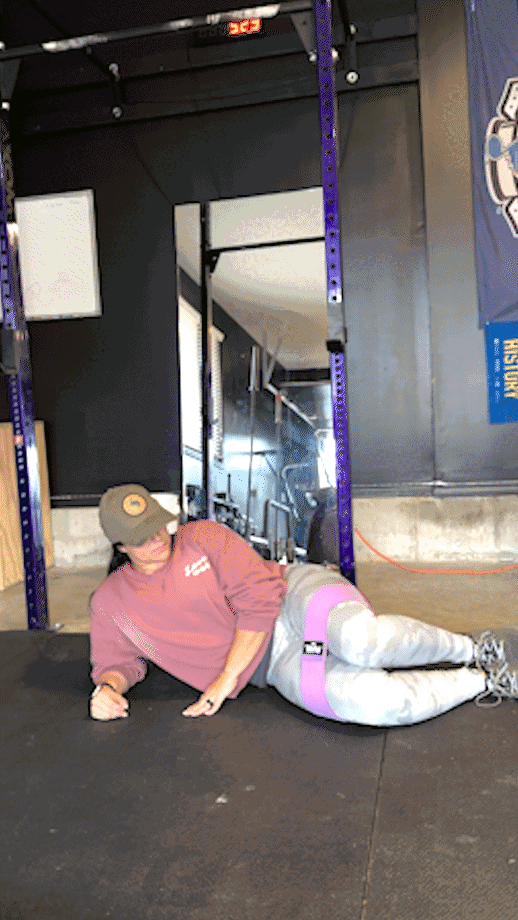
Abductions can be performed one leg at a time or with both legs at the same time. You can stand, sit, lie down, or get on hands and knees in the quadruped position. Here are a few other variations:
- Seated double abduction: In a seated position with a band around your quads, and your legs bent at a 90-degree angle, keep your feet on the floor (they can move a little), and press your knees into the band. Use slow and controlled movements and keep tension on the band at all times.
- Lateral band walk: Standing and with a band around your quads, you’ll walk left to right and back again. The idea is to drive into the ground with your stable leg and step laterally with the opposite leg. In this case, the leg that steps laterally is the one moving away from the midline of your body.
- Fire hydrant: With a band around the quads, you’ll be on your hands and knees for this one. Create a flat back and slightly braced core, so you don’t overcompensate and arch your back. Once you’re set, one knee is going to move off the floor and rotate to the side and away from your core. Only go as far as you can without recruiting your back. It’s easy to get the whole body involved here to gain an extra two inches range of motion.
Banded Kickback
During a kickback, your glute is responsible for extending your thigh behind you. I love a good kickback because it feels very isolated and helps establish the sensation of the glute flexing, which is often called the mind-muscle connection. My favorite banded kickback is the standing variation. Here’s how to set it up:
- Position your mini resistance band around your quads or ankles for this one.
- Brace yourself against a wall or squat rack with your torso upright or slightly forward.
- Situate your bodyweight into one foot and without tightening your quads, extend your opposite leg straight behind you as if you leg is a pendulum.
- Purposely flex and squeeze your butt at the top range of motion.
- This extension should not bring your leg more than 45-degrees off the floor—anything more will likely recruit other muscles.
- Slowly lower your foot back toward the floor and repeat.
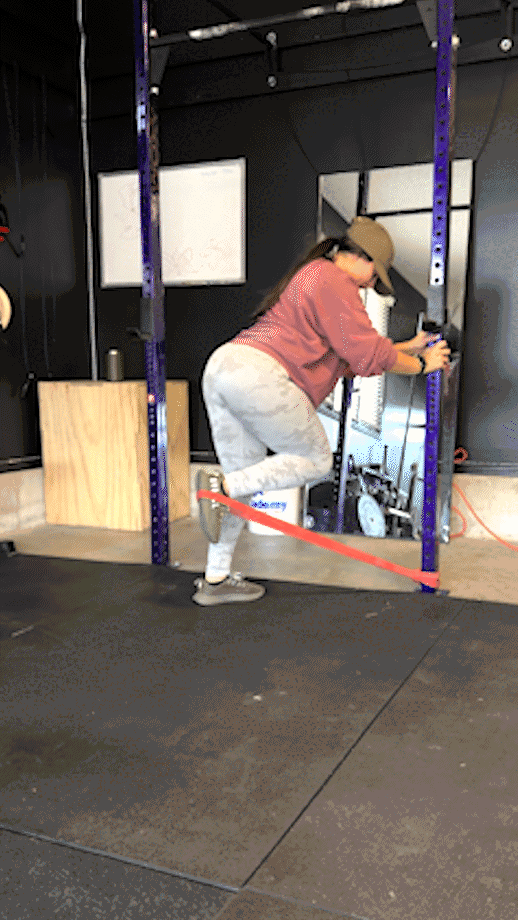
Kickbacks can be done either standing or kneeling. Here are a few variations:
- Standing 45-degree kickback: Same idea as the traditional kickback but instead of kicking straight behind you, bring your leg out at a slight 45-degree angle.
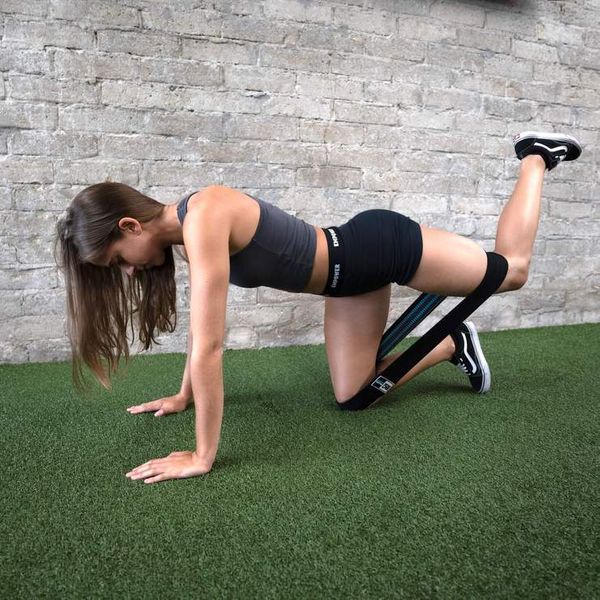
- Donkey kicks: On your hands and knees with your back flat and core slightly braced, you’ll lift one leg and keep it bent at a 90-degree angle. Without extending through your back, you’ll flex and squeeze the glute to bring your leg straight back behind you and upward so that the sole of your foot is facing the ceiling. Keep the 90-degree angle in your leg at all times and come back to the starting position.
Resistance Band Exercises for Glutes: Final Thoughts
Whether you’re looking to increase muscle size or improve your athletic performance, glute isolation exercises shouldn’t be overlooked. Adding any of the resistance band exercises for glutes I’ve covered in this guide will absolutely lead to a tremendous butt workout and potentially some of these other benefits:
- Increased overall leg strength
- Increased muscle size
- Relieve lower back pain
- Help reduce knee pain
Resistance Band Exercises for Glutes: Q&A
Will resistance bands build glutes?
Yes! In fact, according to a 2012 study5, the amount of weight lifted is not the only factor that leads to increased muscle size—it was found that how long a muscle is under tension leads to new muscle growth. Resistance band workouts are unique because they put your muscles under tension during both eccentric and concentric portions of an exercise.
How do you work your glutes with resistance bands?
There are many different exercises you can do with resistance bands to target your glutes including glute bridges, hip thrusts, kickbacks, clam shells, and lateral band walks.
Where do you put a resistance band on your glutes?
For glute-specific exercises, the mini loop resistance band will sit on your quads, right above the knees. For some people, it can be more appropriate to put the band around the ankles or shins. Either way, you’ll get the most out of your reps when the band is taut and provides constant tension and feedback for your gluteus medius (the outside of your butt).
References
- Barton CJ, Lack S, Malliaras P, Morrissey D. Gluteal muscle activity and patellofemoral pain syndrome: a systematic review. Br J Sports Med. 2013;47(4):207-214. doi:10.1136/bjsports-2012-090953
- Jeong UC, Sim JH, Kim CY, Hwang-Bo G, Nam CW. The effects of gluteus muscle strengthening exercise and lumbar stabilization exercise on lumbar muscle strength and balance in chronic low back pain patients. J Phys Ther Sci. 2015;27(12):3813-3816. doi:10.1589/jpts.27.3813
- Elzanie A, Borger J. Anatomy, Bony Pelvis and Lower Limb, Gluteus Maximus Muscle. [Updated 2023 Mar 28]. In: StatPearls [Internet]. Treasure Island (FL): StatPearls Publishing; 2023 Jan-.
- Millar NA, Colenso-Semple LM, Lockie RG, Marttinen RHJ, Galpin AJ. In-Season Hip Thrust vs. Back Squat Training in Female High School Soccer Players. Int J Exerc Sci. 2020;13(4):49-61. Published 2020 Feb 1.
- Burd NA, Andrews RJ, West DW, et al. Muscle time under tension during resistance exercise stimulates differential muscle protein sub-fractional synthetic responses in men. J Physiol. 2012;590(2):351-362. doi:10.1113/jphysiol.2011.221200
- Lam JH, Bordoni B. Anatomy, Shoulder and Upper Limb, Arm Abductor Muscles. [Updated 2023 Aug 30]. In: StatPearls [Internet]. Treasure Island (FL): StatPearls Publishing; 2023 Jan-.


